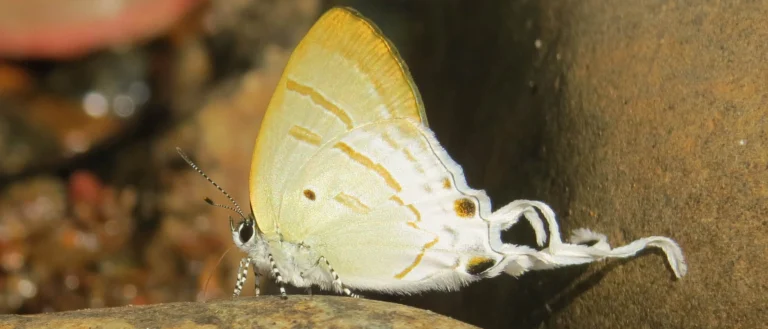How Do Monarch Butterflies Mate? A Complete Guide
Monarch butterflies have a special mating process. Males spot females based on their size and distinct color patterns. To attract a mate, males release specific scents called pheromones. When a male and female connect, the male passes a sperm packet, known as a spermatophore, to the female. This sperm is stored by the female and used later to fertilize her eggs. Once ready, females lay these fertilized eggs on milkweed plants, ensuring the next generation’s start.
Table of Contents
Introduction
Monarch butterflies are amazing creatures. Many people recognize them because of their beautiful orange and black wings. But there’s so much more to them than their looks! They travel long distances, have special behaviors, and go through big changes in their lives.
One of the most interesting parts about these butterflies is how they find a partner and create a new life. In this guide, we’ll explore everything about how do monarch butterflies mate.
Life Cycle Overview
The Four Stages of a Monarch’s Life
Every butterfly, including the monarch, goes through four main stages in its life. It’s like a journey from being very small to flying high in the sky. Let’s look at these stages:
- Egg: Everything starts here. Female monarchs lay tiny, white eggs, usually on milkweed plants. These eggs are the future butterflies waiting to come out.
- Larva (Caterpillar): After a few days, a tiny caterpillar comes out of the egg. This caterpillar is very hungry and eats a lot of leaves. It grows bigger and bigger, shedding its skin a few times.
- Pupa (Chrysalis): When the caterpillar is done growing, it finds a safe spot and wraps itself in a protective shell called a chrysalis. Inside, a big change happens. The caterpillar transforms, getting ready to become a butterfly.
- Adult (Butterfly): After some time, the chrysalis opens, and out comes a beautiful monarch butterfly! It stretches its wings, gets ready, and soon starts flying.
It’s during the butterfly stage that they look for a partner and mate. This mating is very important because it ensures that new eggs are laid, and the life cycle begins all over again.
Identifying Male and Female Monarchs
Monarch butterflies, like many animals, have males and females. But how can we tell them apart just by looking? It’s easier than you might think! Both are beautiful, but there are some differences in how they look and act:
Physical Differences
Black Spots
If you look closely at a monarch’s wings, you might see two black spots on the hind wings (the lower pair of wings) of some of them. These spots are a sign that the butterfly is a male! Female monarchs don’t have these spots.
Body Size and Color
Males usually have a slightly slimmer body compared to females. Their color might also be a bit brighter or lighter than the females.
Behavioral Differences
Who’s Chasing Who?
Males are usually the ones you’ll see flying around more actively, especially when they’re looking for a female to mate with. They’re the ones that often chase after the females.
Understanding these differences is the first step. Once we know if a monarch is male or female, we can then learn more about how they come together and mate.
Monarch Butterflies Mating Rituals & Behavior
The world of monarch butterflies is filled with color, grace, and intriguing behaviors, especially when it comes to finding a mate.
Mating Initiation
Spotting from Afar
Males have excellent vision, which allows them to spot females from a distance. This visual cue is the first step in the mating initiation.
The Chase
Once they set their eyes on a potential mate, males start the chase. It’s a dance in the sky, with sharp turns, twists, and dives.
Hovering Overhead
If a female is interested, she might allow the male to hover over her. This behavior is the butterfly equivalent of holding hands, a sign of acceptance.
Courtship Connection
The Gentle Descent
Before the actual mating, the two butterflies often descend to the ground or perch on a plant. This gives them the stability they need for the next steps.
Sticking Together
Their connection during mating is unique. It’s a testament to nature’s design that ensures the continuation of species.
A Gentle Hold
The male’s claspers are like gentle hands, holding the female delicately but firmly. This connection ensures that the sperm is transferred securely.
Duration and After
A Time of Bonding
While we might think of mating as a quick act, for monarchs, it’s a time of bonding. They can remain connected for hours, basking in the sun or resting under leaves.
Gifts from the Male
Beyond just sperm, the male transfers a spermatophore, a package filled with proteins and nutrients. It’s his gift to the female, helping her have healthier eggs.
Role of Pheromones in Mating
In the insect world, communication isn’t just about what you see or hear. It’s also about what you smell. Monarch butterflies, like many other creatures, use special chemicals called pheromones to send messages to each other, especially when it comes to finding a mate.
The World of Pheromones
Nature’s Perfume: Pheromones are like nature’s perfumes. These are chemicals that butterflies release, which other butterflies can smell or sense.
Silent Messages: Through these pheromones, butterflies can send silent messages, like “I’m ready to mate,” or “I’m not interested.”
Pheromones in Action
Attracting a Mate: Female monarchs release specific pheromones when they are ready to mate. These chemicals signal the males that she’s available.
Guiding the Chase: Once a male picks up on these pheromones, it can guide him directly to the female, even if she’s some distance away. It’s like following a scent trail.
Influencing Choices
Quality Over Quantity: Not all pheromones are created equal. Some studies suggest that the strength or type of pheromone female releases can give clues about her health or age. Males might prefer females giving off certain pheromone signals, as it could mean healthier offspring.
Understanding the role of pheromones gives us a glimpse into the silent conversations happening all around us in nature. For the monarch butterfly, these chemical signals play a crucial part in ensuring the success of monarch butterflies’ mating rituals.
Egg-laying, Fertilization, and Reproduction
Once the monarch butterflies have completed their dance of attraction and mating, the next important step in their life cycle is the creation of new life. Here’s how this incredible process unfolds:
Storing for Later
A Female’s Secret Chamber: After mating, females store the sperm they receive in a special pouch called a ‘spermatheca‘. This allows her to choose the right time for fertilizing her eggs, ensuring the best chances for her offspring’s survival.
Long-term Storage: Amazingly, a female can store this sperm for several weeks, using it bit by bit as she lays her eggs.
The Mode of Reproduction
Nature’s Choice: Monarch butterflies reproduce sexually, which means that they need two partners – a male and a female – to create new life. This process ensures genetic diversity, making the next generation stronger and more resilient.
The Act of Laying Eggs
A Careful Search: Not every leaf is good enough for a monarch’s eggs. Females are very picky, often choosing milkweed plants. This plant provides the necessary food for the caterpillars once they hatch.
The Delicate Process: When ready, the female attaches each tiny, pearl-like egg to the underside of a leaf. This keeps them safe from predators and harsh weather.
Fertilization Inside and Out:
Internal Magic: As the female lays each egg, she releases some of the stored sperm to fertilize it. This ensures that when the egg hatches, a new caterpillar will emerge, ready to start its journey of life.
Protecting the Future: The egg’s outer layer is tough, protecting the delicate life inside from the outside world.
Every step in this process, from choosing the right partner to selecting the best leaf for an egg, shows the delicate balance of nature and the incredible journey of life that each monarch butterfly undertakes.
Factors Affecting Mating Success
In the natural world, successful mating isn’t just about finding a partner. Several factors, both internal and external, can influence the success rate of monarch butterflies’ mating rituals.
The Importance of Age and Size
Prime Time
Just like in many species, age plays a role in the mating success of monarchs. Younger butterflies, fresh after their metamorphosis, are more vibrant and might have a higher mating success due to their peak physical condition.
Size Matters
Bigger might indeed be better when it comes to monarchs. Larger butterflies, especially males, often have an advantage, being more visible and potentially more attractive to potential mates.
Environmental Conditions
The Weather’s Role
A rainy day isn’t just bad for picnics; it can hinder monarchs’ mating activities. Optimal weather conditions, particularly warmth and calmness, are essential for successful mating flights.
Seasonal Cues
The length of daylight and the position of the sun can signal to monarchs that it’s mating season. These natural timekeepers ensure that mating happens during the best times of the year.
Threats During Mating
Predators on the Prowl
The act of mating requires focus and time, making the paired monarchs more vulnerable to predators like birds or even other insects.
Disturbances
Human activities, such as agricultural practices or even simple movements in butterfly-viewing areas, can disrupt the delicate mating process.
Migration and Mating
Monarch butterflies are famous for their incredible migration journeys. These epic treks span thousands of miles, linking together generations of butterflies. But how does this migration intertwine with their mating rituals?
Migration Basics
Nature’s Marvel: Monarch butterflies, especially those in North America, undertake an awe-inspiring migration from Canada to Mexico every year. This journey ensures their survival during the colder months.
Generational Relay: Interestingly, the monarchs that start the migration are not the ones that complete it. It’s a relay across 3-4 generations.
Influence on Mating
Delaying the Dance: Migrating monarchs delay reproduction to conserve energy. Instead of mating, they focus on the long journey ahead. Their bodies divert resources usually reserved for reproduction to enhance their flight muscles and fat stores.
Springtime Resumption: As the spring migration begins, the reproductive processes in the monarchs reactivate. Mating then becomes a priority to ensure the next generation is born to continue the migration back north.
Resident vs. Migratory Populations
Different Lives: Not all monarchs migrate. For instance, resident populations in places like Florida or California might not undertake the long journey. Their mating behaviors are, thus, not influenced by the need to travel.
Continuous Cycle: These resident monarchs may reproduce several times throughout the year, without the reproductive hiatus seen in their migratory counterparts.
Migration’s Protective Role
Escaping Threats: By migrating, monarchs avoid adverse conditions and potential threats, like cold temperatures, which can impact reproductive success.
Genetic Diversity Boost: The mingling of butterflies from different origins during migration might increase genetic diversity, leading to a stronger, more resilient population.
Threats to Monarch Butterfly Mating and Reproduction
Monarch butterflies face a multitude of threats in today’s world. These challenges not only endanger their survival but also directly impact their mating and reproduction.
Human-made Challenges
Habitat Loss
As forests get cleared for agriculture or urbanization, monarchs lose vital breeding and feeding grounds. Milkweed plants, crucial for laying eggs and feeding caterpillars, are in decline due to these activities.
Pesticides and Herbicides
These chemicals, widely used in agriculture, can poison monarchs directly or destroy their food sources. The loss of milkweed due to herbicides is particularly concerning.
Climate Change
Global temperature changes can disrupt the monarchs’ migration patterns, potentially leading them to areas less suitable for mating and egg-laying.
Natural Threats
Predators
From spiders to birds, monarchs face numerous natural predators. While their bright colors serve as a warning (indicating their toxic nature due to consuming milkweed), some predators still pose threats, especially to eggs and caterpillars.
Parasites and Diseases
The Ophryocystis elektroscirrha (OE) parasite is a significant concern. Infected butterflies can be weaker, reducing their chances of successful mating.
Harsh Weather
Unexpected cold snaps, storms, or prolonged rain can be detrimental, affecting their ability to mate or lay eggs.
Indirect Threats
Migratory Challenges
While migration ensures their survival during colder months, the journey itself is perilous. Facing various hazards along the way, many monarchs don’t survive to mate.
Reduced Genetic Diversity
With declining populations, there’s a risk of reduced genetic diversity, which can make the species more vulnerable to diseases or environmental changes.
Unique Monarch Butterflies Mating Behaviors and Facts
Monarch butterflies, while common in many places, have some behaviors and facts that can surprise and delight even the most seasoned butterfly enthusiast. Let’s take a look at some of these unique characteristics:
Do Monarchs Mate for Life?
Unlike some animals that find a mate for life, monarch butterflies don’t form long-term partnerships. Their mating is more about ensuring the next generation than forming lasting bonds.
Each mating session is a separate encounter, and both males and females can mate with multiple partners in their lifetime.
Aerial Support
One of the more enchanting sights is seeing two monarchs flying together during their mating ritual. While it may appear they are supporting or even carrying each other, in reality, they’re engaged in a mutual aerial dance, each butterfly flitting and floating in tandem.
Life After Mating
The Males’ Sacrifice
A common myth is that male monarchs die after mating. This isn’t strictly true. While the act of mating can be taxing, and males might have a shorter lifespan after mating several times, they don’t die immediately afterward.
Females’ Journey
Post-mating, females go on a crucial mission to find the perfect spots to lay their fertilized eggs. This quest consumes much of their remaining life, emphasizing the importance of reproduction in their life cycle.
Other Intriguing Facts
Temperature Play
Did you know that the temperature can influence the sex of the offspring? Cooler conditions might lead to more male butterflies, while warmer conditions can produce more females.
Safety in Numbers
Sometimes, multiple females lay their eggs on the same plant. This isn’t just a coincidence. A group of eggs can deter certain predators, offering a higher chance of survival for the caterpillars.
Understanding these factors emphasizes how finely tuned nature is. Everything, from the size of the butterfly to the weather conditions, plays a part in ensuring the continuation of the monarch species.
Conclusion
Monarch butterflies are truly special. Their bright colors, long migrations, and unique mating rituals make them stand out. But like many creatures, they face challenges. Both nature and human activities can make life hard for them.
Because of these challenges, it’s crucial for us to learn and care about monarchs. When we know about their mating habits and life cycle, we understand how to help them better. Simple steps, like planting milkweed or reducing pesticide use, can make a big difference.
In the end, helping monarch butterflies is about more than just one species. It’s about keeping our world colorful, balanced, and full of wonder. Every action counts, and everyone can play a part in this important mission.


